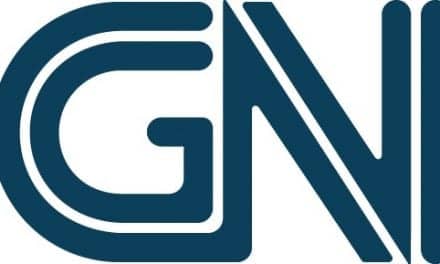Distance education can get trained technicians “on the ground” and allow large populations in remote areas to gain access to quality hearing care
The global online educational training program for hearing care technicians, in collaboration with the University of New England College of Osteopathic Medicine, is designed to help meet the capacity of caring for the nearly 600 million individuals worldwide with hearing loss. The International Hearing Care Technician Certificate requires 20 clock hours of education and is accessible online. It is geared for individuals who will assist professional providers such as audiologists, otolaryngologists, or other qualified physicians. Courses are currently taught in English and Spanish by an international faculty, with more languages to follow.
According to the World Health Organization (WHO),1 nearly 300 million people worldwide, including 78 million children, suffer from moderate to profound hearing loss. The estimate approaches over 600 million people when the hearing loss category is expanded to include mild losses. The vast majority of these people live in developing countries, where there is a shortage of food, water, and basic health care.
WHO attributes hearing loss in low-income countries mainly to infectious diseases, such as meningitis, measles, mumps, and chronic ear infections. Other common causes include genetics, exposure to excessive noise, head and ear injury, aging, otitis media, and the use of ototoxic drugs. Therefore, it’s important to remember that as many as half of all cases of deafness and hearing loss are avoidable through prevention, early diagnoses, and management.
Dr Margaret Chan, director general of the WHO, in her May 2012 address at the 65th World Health Assembly, stated, “WHO estimates that nearly 40% of people older than 65 years have a disabling hearing impairment.”2 According to WHO’s World Report on Disability,3 62 million people ages 60+ experience hearing loss, of which 70% live in low- and middle-income countries. These populations do not have the same treatment options that are available to people with hearing loss in more developed economies. They also do not have access to trained hearing healthcare professionals.
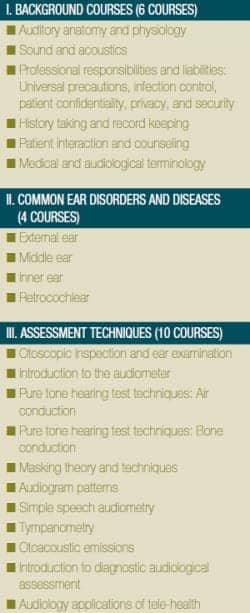
Table 1. Basic IHCT curricula.
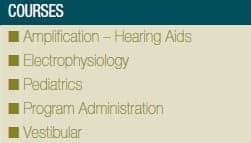
Table 2. Advanced IHCT curricula.
The need for hearing aids is daunting. In developed countries, it is estimated that about 20% of all persons with hearing loss need hearing aids, suggesting 56 million potential hearing aid users worldwide. It is estimated that current hearing aid production meets only 10% of the global need—and only 3% of the need in developing countries.
Bringing Sustained Hearing Care to Hundreds of Millions of People
The overarching challenge then, other than improving economics, is “Who will serve this already large and growing population?” The existing worldwide pool of audiologists, ENT physicians, and other hearing care providers cannot possibly meet this capacity; likewise, degree-granting universities cannot possibly graduate nearly enough practitioners to meet today’s demands, if ever. Furthermore, there are simply not enough degree-seeking students, and in most regions no formal academic programs exist. For example, in the Dominican Republic, there are 11 million people but only approximately 70 otolaryngologists and virtually no audiologists. There is a demand for hearing healthcare, but there is no short-term ability to meet this demand.
Consequently, in 2006, the WHO published a Primary Ear and Hearing Care Training Resource, which consists of four manuals.4 Although well intentioned, this printed material cannot possibly train technical support personnel to a level that most hearing care professionals would deem as acceptable. Providing quality access to hearing healthcare worldwide requires thousands of well-trained support personnel.
The solution requires us to identify and educate local individuals to become hearing care technicians. These individuals need to be recruited, educated, trained, and supervised by audiologists, ENTs, or other available physicians or medical practitioners. This supervision may incorporate those aspects of tele-audiology presented by the other contributing authors in this special edition of HR.
Distance Education: A Means to Meet Capacity and Sustainability—and Upward Economic Mobility
Training via distance education is not new. It has long been used as a viable means of reaching students and creating economic opportunities for those who otherwise may not have access. In 1728, Caleb Phillips, the American creator of shorthand, promoted his techniques via a mail-order course. It was, however, limited to the elite, the clergy, and the aristocracy. As time passed, distance education became more egalitarian. In fact, the first “global view” of distance education is attributed to Sir Isaac Pitman in 1784, an Englishman who recognized that his method of shorthand could be made available to students throughout the world via mail delivery.
Distance education became a method of reaching individuals who had limited access to traditional brick-and-mortar education. In 1873, Anna Ticknor created a society to encourage at-home studies for women—the first US “correspondence school.” This society provided at-home education and career opportunities for over 10,000 women during a 24-year period. By the 1890s, many US universities—including Chautaqua College of Liberal Arts, Yale, Johns Hopkins, and others—were offering degrees through distance education.
Today, virtually all higher education and trade schools recognize and utilize some aspect of distant education to reach populations around the globe. Most faculty and students of audiology are very familiar with the online transitional AuD degree programs and its coincidence with the emergence of the Internet. The advent of technology and high bandwidth “streaming” has now allowed education to be delivered virtually anywhere, including handheld mobile devices. Today, Web-based training, along with high-quality video, is recognized as an efficient and cost-effective way to deliver education and interact with faculty in new and innovative ways.
The International Hearing Care Technician Certificate
The American Institute of Continuing Medical Education (AICME) and the University of New England College of Osteopathic Medicine (UNECOM) had previously developed a strategic alliance in the creation of an online global medical education platform. Many of their courses were already focused on audiology and otology topics, often used to help educate primary care physicians on how best to utilize these specialties.
The AICME Web-based platform was the perfect vehicle for expansion into an International Hearing Care Technician Certificate Program, with the certificate to be awarded jointly by AICME and UNECOM.In the summer of 2011, a steering committee chaired by James W. Hall, PhD, and Jackie Clarke, PhD—both of whom have extensive international teaching experience and outreach to underserved populations—along with the author began to craft model curricula for an international hearing care technician certificate. Joining the committee were two well-respected neurotologists, Herbert Silverstein, MD, and James Saunders, MD. Drs Saunders and Clarke have been active participants and advocates for the development of hearing healthcare in emerging economies, particularly in Central America and Africa, and have served as co-chairs of the Coalition for Global Hearing Health.4 They also have long established roots in the international arenas as Humanitarian Committee chairs within the American Academy of Otolaryngology-Head and Neck Surgery Foundation and the International Society of Audiology, respectively.
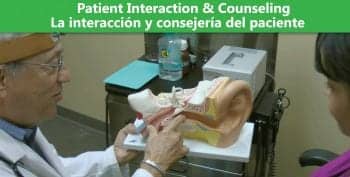
Figure 1. Video of patient interaction and counseling.
The Steering Committee’s objectives were straightforward: create reasonable and attainable curricula that could be delivered online to a student who may have no more than a high-school-level education and perhaps no background whatsoever in any aspects of hearing healthcare. The technician’s skill-set and role would not be unsupervised or acting autonomously without the supervision, in some manner, by an audiologist or physician. Table 1 shows the composition of the 20-clock-hour curricula. It is comprised of three groupings: 1) Background (6 courses); 2) Common Ear Disorders and Diseases (4 courses), and 3) Assessment Techniques (10 courses). The curricula were well received when presented at the 2nd Coalition for Global Hearing Health Conference in Los Angeles at the House Research Institute in September 2011.5
In anticipation of those individuals who wish to further their education upon completion of the basic curricula and to meet capacity in several specialty areas (eg, pediatrics), advanced curricula reflecting specialty areas are being planned and developed (Table 2).
In the creation and implementation of a global online education and training program developed for emerging economies, the goal was to remove as many boundaries as possible. In doing so, the following components designed to maximize access and affordability have been included:
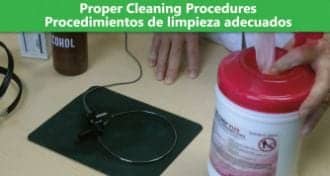
Figure 2. Video of proper cleaning procedures and techniques.
- Courses are asynchronous, available 24-7, and do not have to be taken at a specific time. There are no scheduling issues of day or time.
- They are in the format of enduring materials. The student downloads the videos, handouts, and reading materials and posts them just like a textbook. They can review and watch them again and again.
- There are no additional textbooks or materials to purchase, avoiding complications of international mail delivery.
- An international faculty has been assembled with the faculty speaking in their native language—presently, English and Spanish with more to follow. This minimizes the distraction of subtitles, translation, or dubbing.
- Videos and lectures are at the appropriate level of instruction and have been enhanced with graphics to emphasize the concepts. Examples of this approach can be seen in still shots of several videos (see Figures 1-3).
- Cost for the entire 20-clock-hour curricula is US$795. Funding may be provided to students through individual sponsorships, corporations, national funding sources, and faith-based organizations.
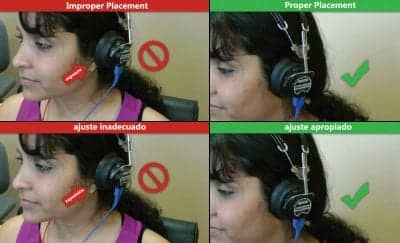
Figure 3. Video of puretone hearing test techniques.
Summary
There are nearly 600 million people around the world in need of hearing healthcare. A primary obstacle is the lack of trained individuals to serve this growing population—primarily in emerging economies. An online global education program has been created in collaboration with the American Institute of Continuing Medical Education and the University of New England College of Osteopathic Medicine designed to train technicians. The International Hearing Care Technician Certificate will help meet the capacity to serve the hearing-impaired population while creating sustainability and meaningful jobs for individuals in the communities they serve.
The program will be available with courses taught in English and Spanish this fall (2012).
Acknowledgements
The author thanks Marc Hahn, DO, dean and senior vice-president of health affairs, and Kenneth Johnson, DO, associate dean for educational programs, of the University of New England College of Osteopathic Medicine for their vision, ongoing support, and encouragement for this program.
CORRESPONDENCE can be addressed to:
References
- World Health Organization (WHO). Global Burden of Disease, World Health Organization (WHO), 2000. Available at: cdrwww.who.int/healthinfo/paper50.pdf
- WHO. Prevention of blindness and deafness. Available at: www.who.int/pbd/deafness/en
- WHO. World Report on Disability, 2011. Available at: a target=”_blank” href=”http://whqlibdoc.who.int/publications/2011/9789240685215_eng.pdf”>whqlibdoc.who.int/publications/2011/9789240685215_eng.pdf
- WHO. Primary Ear and Hearing Care Training Resource. 2006. Available at: www.who.int/pbd/deafness/activities/hearing_care/en/
- Coalition for Global Hearing Health. Available at: cfghh.squarespace.com
ALSO IN THIS SPECIAL ISSUE (OCTOBER 2012) ON TELEAUDIOLOGY:
- Extending Hearing Healthcare: Tele-audiology, by Jerry Northern, PhD
- The Need for Tele-audiometry, by De Wet Swanepoel, PhD
- Are You Ready for Remote Hearing Aid Programming? By Jason Galster, PhD, and Harvey Abrams, PhD
- Infant Diagnostic Evaluations Using Tele-audiology, by Deborah Hayes, PhD
- Online Global Education and Training, by Richard E. Gans, PhD
- Therapeutic Patient Education via Tele-audiology: Brazilian Experiences, Deborah Viviane Ferrari, PhD
- Telepractice in the Department of Veterans Affairs, by Kyle C. Dennis, PhD, Chad F. Gladden, AuD, and Colleen M. Noe, PhD
Citation for this article:
Gans RE. Online Global Education and Training Hearing Review. 2012;19(10):34-38.





